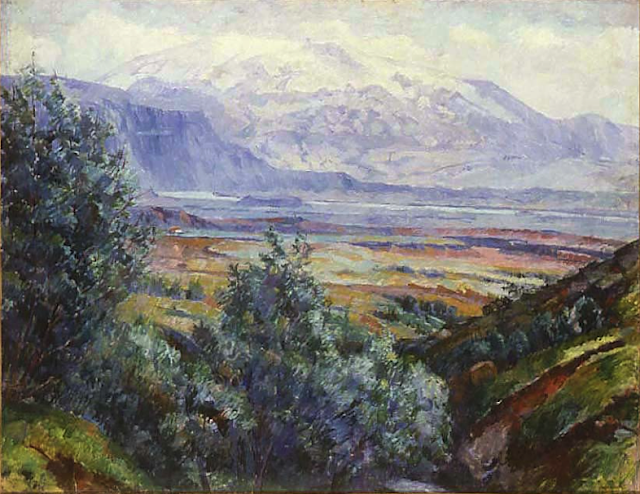ÁSGRIMUR JONSSON (1876–1958)
Hekla (1,488m - 4,882ft)
Iceland
In Hekla, 1927, oil on canvas
The mountain
Hekla or Hecla (1,488m - 4,882ft) is a stratovolcano in the south of Iceland. Hekla is one of Iceland's most active volcanoes; over 20 eruptions have occurred in and around the volcano since 874. During the Middle Ages, Europeans called the volcano the "Gateway to Hell".Hekla is part of a volcanic ridge, 40 km (25 mi) long. The most active part of this ridge, a fissure about 5.5 km (3.4 mi) long named Heklugjá, is considered to be within Hekla proper. Hekla looks rather like an overturned boat, with its keel being a series of craters, two of which are generally the most active.
The volcano's frequent large eruptions have covered much of Iceland with tephra, and these layers can be used to date eruptions of Iceland's other volcanoes. Approximately 10% of the tephra created in Iceland in the last thousand years has come from Hekla, amounting to 5 km3. Cumulatively, the volcano has produced one of the largest volumes of lava of any in the world in the last millennium, around 8 km3.
The earliest recorded eruption of Hekla took place in 1104. Since then there have been between twenty and thirty considerable eruptions, with the mountain sometimes remaining active for periods of six years with little pause. Eruptions in Hekla are varied and difficult to predict. Some are very short (a week to ten days) whereas others can stretch into months and years (the 1947 eruption started 29 March 1947 and ended April 1948). But there is a general correlation: the longer Hekla goes dormant, the larger and more catastrophic its opening eruption will be.
The most recent eruption was on 26 February 2000.
Hekla is a popular destination for hiking. Following the most recent eruption the path goes most of the way to the summit; the walk takes 3 to 4 hours. In spring, skiing is possible on short routes around the rim of the crater. In summer, there are easy (F) mountaineering routes also around the crater rim, and it is possible to snowcat to the top in winter. The volcano can be reached using the buses to Landmannalaugar 30 km further east, and it is possible to stay or camp at farms in the area. A visitor centre, The Hekla Center at Leirubakki Farm, opened in 2007.
The painter
Asgrímur Jónsson was an Icelandic painter, and one of the first in the country to make art a professional living. He studied at the Royal Academy in Copenhagen between 1900 and 1903 and traveled widely after graduation. The subjects of his pictures are mostly the landscapes of his home country, particularly mountains. His painting style is similar to the French impressionists like Corot. Some of his pictures also illustrate Icelandic sagas and folk tales.
He was also noted for his murals in various churches in Iceland. A number of his works are on display in the National Gallery of Iceland. Jónsson influenced many artists in Iceland. A short time before he died he had donated his house in Reykjavík to the Icelandic Government along with all those paintings which were at that time in his possession. These consisted of 192 oil paintings and 277 water colours together with a great number of unfinished pictures dating from various periods in his life. During his lifetime Ásgrímur Jónsson was honoured in many ways. He was made honorary professor at the University of Iceland and, in 1933 he was made Grand Knight of the Icelandic Order of the Falcon. He was an honorary member of the Royal Swedish Academy of Arts and Knight of Dannebrog, first class. He died in 1958 and was buried in Gaulverjabær.
_______________________________
2017 - Wandering Vertexes...
by Francis Rousseau
